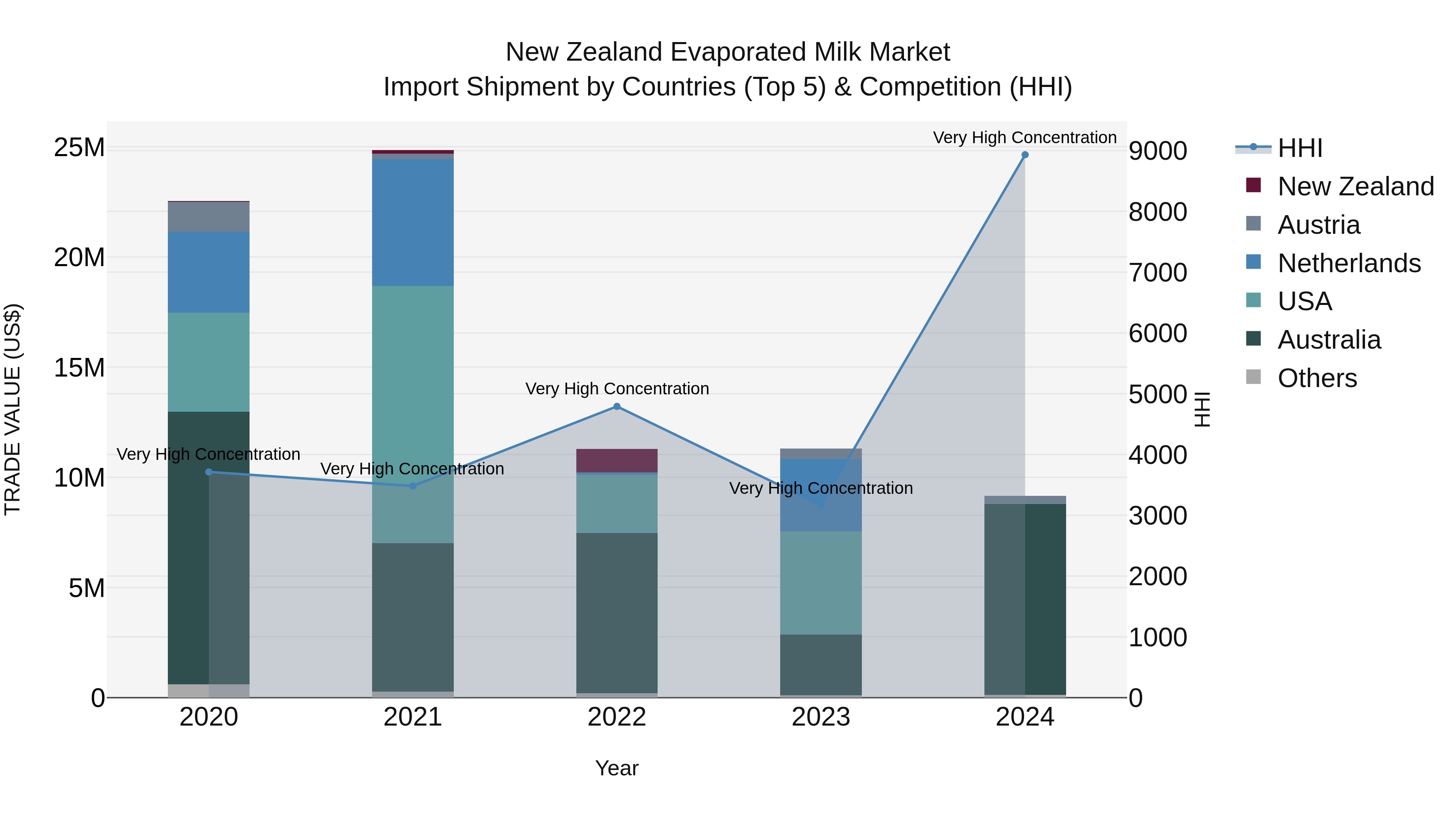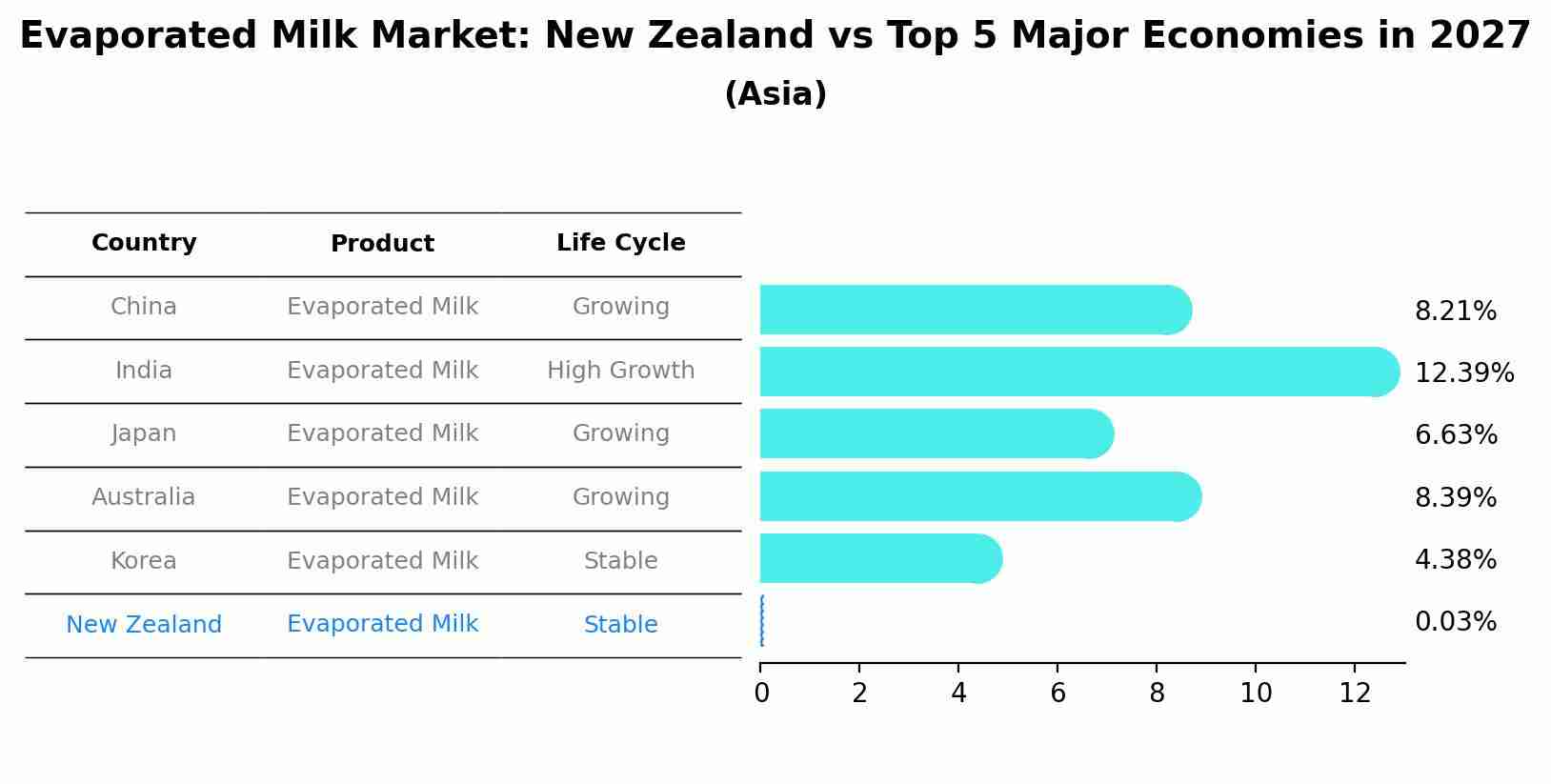New Zealand Evaporated Milk Market (2025-2031) | Industry, Size, Analysis, Outlook, Segmentation, Trends, Growth, Companies, Forecast, Revenue, Value & Share
| Product Code: ETC4850322 | Publication Date: Nov 2023 | Updated Date: Nov 2025 | Product Type: Market Research Report | |
| Publisher: 6Wresearch | Author: Shubham Padhi | No. of Pages: 60 | No. of Figures: 30 | No. of Tables: 5 |
New Zealand Evaporated Milk Market Top 5 Importing Countries and Market Competition (HHI) Analysis
Despite the high concentration of evaporated milk import shipments in New Zealand in 2024, the market saw a significant decline in both the compound annual growth rate (CAGR) and growth rate from 2020 to 2024. Top exporting countries like Australia, Austria, Belgium, Italy, and Metropolitan France continued to dominate the market. The negative growth rates indicate potential challenges or shifts in consumer preferences impacting the industry. Monitoring evolving trends and adapting strategies accordingly will be crucial for stakeholders to navigate the changing landscape of the New Zealand evaporated milk market.

Evaporated Milk Market: New Zealand vs Top 5 Major Economies in 2027 (Asia)
By 2027, the Evaporated Milk market in New Zealand is anticipated to reach a growth rate of 0.03%, as part of an increasingly competitive Asia region, where China remains at the forefront, supported by India, Japan, Australia and South Korea, driving innovations and market adoption across sectors.

Key Highlights of the Report:
- New Zealand Evaporated Milk Market Outlook
- Market Size of New Zealand Evaporated Milk Market, 2024
- Forecast of New Zealand Evaporated Milk Market, 2031
- Historical Data and Forecast of New Zealand Evaporated Milk Revenues & Volume for the Period 2021-2031
- New Zealand Evaporated Milk Market Trend Evolution
- New Zealand Evaporated Milk Market Drivers and Challenges
- New Zealand Evaporated Milk Price Trends
- New Zealand Evaporated Milk Porter`s Five Forces
- New Zealand Evaporated Milk Industry Life Cycle
- Historical Data and Forecast of New Zealand Evaporated Milk Market Revenues & Volume By Type for the Period 2021-2031
- Historical Data and Forecast of New Zealand Evaporated Milk Market Revenues & Volume By Skimmed for the Period 2021-2031
- Historical Data and Forecast of New Zealand Evaporated Milk Market Revenues & Volume By Whole for the Period 2021-2031
- Historical Data and Forecast of New Zealand Evaporated Milk Market Revenues & Volume By Distribution Channel for the Period 2021-2031
- Historical Data and Forecast of New Zealand Evaporated Milk Market Revenues & Volume By Online for the Period 2021-2031
- Historical Data and Forecast of New Zealand Evaporated Milk Market Revenues & Volume By Offline for the Period 2021-2031
- New Zealand Evaporated Milk Import Export Trade Statistics
- Market Opportunity Assessment By Type
- Market Opportunity Assessment By Distribution Channel
- New Zealand Evaporated Milk Top Companies Market Share
- New Zealand Evaporated Milk Competitive Benchmarking By Technical and Operational Parameters
- New Zealand Evaporated Milk Company Profiles
- New Zealand Evaporated Milk Key Strategic Recommendations
Frequently Asked Questions About the Market Study (FAQs):
1 Executive Summary |
2 Introduction |
2.1 Key Highlights of the Report |
2.2 Report Description |
2.3 Market Scope & Segmentation |
2.4 Research Methodology |
2.5 Assumptions |
3 New Zealand Evaporated Milk Market Overview |
3.1 New Zealand Country Macro Economic Indicators |
3.2 New Zealand Evaporated Milk Market Revenues & Volume, 2021 & 2031F |
3.3 New Zealand Evaporated Milk Market - Industry Life Cycle |
3.4 New Zealand Evaporated Milk Market - Porter's Five Forces |
3.5 New Zealand Evaporated Milk Market Revenues & Volume Share, By Type, 2021 & 2031F |
3.6 New Zealand Evaporated Milk Market Revenues & Volume Share, By Distribution Channel, 2021 & 2031F |
4 New Zealand Evaporated Milk Market Dynamics |
4.1 Impact Analysis |
4.2 Market Drivers |
4.2.1 Increasing consumer preference for ready-to-use dairy products |
4.2.2 Growth in the foodservice industry leading to higher demand for evaporated milk |
4.2.3 Rising awareness about the convenience and longer shelf life of evaporated milk |
4.3 Market Restraints |
4.3.1 Fluctuating prices of raw materials such as milk |
4.3.2 Competition from alternative dairy products like condensed milk and powdered milk |
4.3.3 Regulatory challenges related to food safety and quality standards |
5 New Zealand Evaporated Milk Market Trends |
6 New Zealand Evaporated Milk Market Segmentations |
6.1 New Zealand Evaporated Milk Market, By Type |
6.1.1 Overview and Analysis |
6.1.2 New Zealand Evaporated Milk Market Revenues & Volume, By Skimmed, 2021-2031F |
6.1.3 New Zealand Evaporated Milk Market Revenues & Volume, By Whole, 2021-2031F |
6.2 New Zealand Evaporated Milk Market, By Distribution Channel |
6.2.1 Overview and Analysis |
6.2.2 New Zealand Evaporated Milk Market Revenues & Volume, By Online, 2021-2031F |
6.2.3 New Zealand Evaporated Milk Market Revenues & Volume, By Offline, 2021-2031F |
7 New Zealand Evaporated Milk Market Import-Export Trade Statistics |
7.1 New Zealand Evaporated Milk Market Export to Major Countries |
7.2 New Zealand Evaporated Milk Market Imports from Major Countries |
8 New Zealand Evaporated Milk Market Key Performance Indicators |
8.1 Average unit selling price of evaporated milk |
8.2 Consumer awareness and perception surveys on evaporated milk |
8.3 Number of new product launches and innovations in the evaporated milk segment |
9 New Zealand Evaporated Milk Market - Opportunity Assessment |
9.1 New Zealand Evaporated Milk Market Opportunity Assessment, By Type, 2021 & 2031F |
9.2 New Zealand Evaporated Milk Market Opportunity Assessment, By Distribution Channel, 2021 & 2031F |
10 New Zealand Evaporated Milk Market - Competitive Landscape |
10.1 New Zealand Evaporated Milk Market Revenue Share, By Companies, 2024 |
10.2 New Zealand Evaporated Milk Market Competitive Benchmarking, By Operating and Technical Parameters |
11 Company Profiles |
12 Recommendations | 13 Disclaimer |
- Single User License$ 1,995
- Department License$ 2,400
- Site License$ 3,120
- Global License$ 3,795
Search
Thought Leadership and Analyst Meet
Our Clients
Related Reports
- Vietnam System Integrator Market (2025-2031) | Size, Companies, Analysis, Industry, Value, Forecast, Growth, Trends, Revenue & Share
- ASEAN and Thailand Brain Health Supplements Market (2025-2031) | Strategy, Consumer Insights, Analysis, Investment Trends, Opportunities, Growth, Size, Share, Industry, Revenue, Segments, Value, Segmentation, Supply, Forecast, Restraints, Outlook, Competition, Drivers, Trends, Demand, Pricing Analysis, Competitive, Strategic Insights, Companies, Challenges
- ASEAN Bearings Market (2025-2031) | Strategy, Consumer Insights, Analysis, Investment Trends, Opportunities, Growth, Size, Share, Industry, Revenue, Segments, Value, Segmentation, Supply, Forecast, Restraints, Outlook, Competition, Drivers, Trends, Demand, Pricing Analysis, Competitive, Strategic Insights, Companies, Challenges
- Europe Flooring Market (2025-2031) | Outlook, Share, Industry, Trends, Forecast, Companies, Revenue, Size, Analysis, Growth & Value
- Saudi Arabia Manlift Market (2025-2031) | Outlook, Size, Growth, Trends, Companies, Industry, Revenue, Value, Share, Forecast & Analysis
- Uganda Excavator, Crane, and Wheel Loaders Market (2025-2031) | Strategy, Consumer Insights, Analysis, Investment Trends, Opportunities, Growth, Size, Share, Industry, Revenue, Segments, Value, Segmentation, Supply, Forecast, Restraints, Outlook, Competition, Drivers, Trends, Demand, Pricing Analysis, Competitive, Strategic Insights, Companies, Challenges
- Rwanda Excavator, Crane, and Wheel Loaders Market (2025-2031) | Strategy, Consumer Insights, Analysis, Investment Trends, Opportunities, Growth, Size, Share, Industry, Revenue, Segments, Value, Segmentation, Supply, Forecast, Restraints, Outlook, Competition, Drivers, Trends, Demand, Pricing Analysis, Competitive, Strategic Insights, Companies, Challenges
- Kenya Excavator, Crane, and Wheel Loaders Market (2025-2031) | Strategy, Consumer Insights, Analysis, Investment Trends, Opportunities, Growth, Size, Share, Industry, Revenue, Segments, Value, Segmentation, Supply, Forecast, Restraints, Outlook, Competition, Drivers, Trends, Demand, Pricing Analysis, Competitive, Strategic Insights, Companies, Challenges
- Angola Excavator, Crane, and Wheel Loaders Market (2025-2031) | Strategy, Consumer Insights, Analysis, Investment Trends, Opportunities, Growth, Size, Share, Industry, Revenue, Segments, Value, Segmentation, Supply, Forecast, Restraints, Outlook, Competition, Drivers, Trends, Demand, Pricing Analysis, Competitive, Strategic Insights, Companies, Challenges
- Israel Intelligent Transport System Market (2025-2031) | Strategy, Consumer Insights, Analysis, Investment Trends, Opportunities, Growth, Size, Share, Industry, Revenue, Segments, Value, Segmentation, Supply, Forecast, Restraints, Outlook, Competition, Drivers, Trends, Demand, Pricing Analysis, Competitive, Strategic Insights, Companies, Challenges
Industry Events and Analyst Meet
Whitepaper
- Middle East & Africa Commercial Security Market Click here to view more.
- Middle East & Africa Fire Safety Systems & Equipment Market Click here to view more.
- GCC Drone Market Click here to view more.
- Middle East Lighting Fixture Market Click here to view more.
- GCC Physical & Perimeter Security Market Click here to view more.
6WResearch In News
- Doha a strategic location for EV manufacturing hub: IPA Qatar
- Demand for luxury TVs surging in the GCC, says Samsung
- Empowering Growth: The Thriving Journey of Bangladesh’s Cable Industry
- Demand for luxury TVs surging in the GCC, says Samsung
- Video call with a traditional healer? Once unthinkable, it’s now common in South Africa
- Intelligent Buildings To Smooth GCC’s Path To Net Zero


















